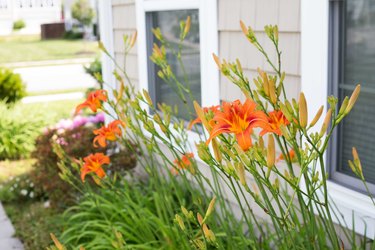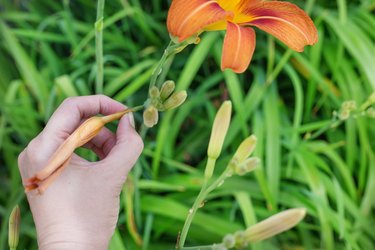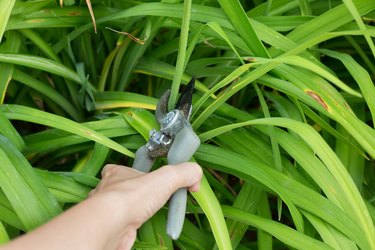
Daylilies (Hemerocallis spp.) give lazy gardeners a double gift. They are herbaceous perennials that grow back and bloom every year -- and they are prolific, providing new plants and fighting erosion with strong roots that sink deeper than do many perennial roots. Even daylilies labeled as self-cleaning, though, benefit from a summer-long program of deadheading, which is the removal of spent blooms and scapes.
Daylily Data
Video of the Day

Daylilies have grown in farm yards, cottage gardens and along the side of American roads since the first plants were brought from Europe by early settlers. Many of the jewel-toned hybrids in modern gardens descend from the tawny daylily (Hemerocallis fulva), hardy in U.S. Department of Agriculture plant hardiness zones 3 through 9 and lemon lilies (Hemerocallis lilioasphodelus), hardy in USDA zones 4 through 10 and used by early hybridizers.
Video of the Day
There are species and hybrids hardy in U.S. Department of Agriculture plant hardiness zones 3 through 10, so there's a daylily with its grassy foliage and bunches of day-long blooms for almost every garden. The plant is named for its tendency to throw up branches, called scapes, that hold a dozen or more flower buds that open in succession for approximately one day at a time.
What Remains

As daylilies bloom, they leave spent flower heads. A completed scape might hold numerous withering remains as well as one or two green seed pods. The flower remains can be unsightly on an exceptionally floriferous hybrid. More importantly, the seed pods take energy from the plant. If the seeds are part of a hybridizing project, it might be worth the loss of vigor for the plant -- but since daylily seeds seldom grow true to the parent plant, they're just a waste of energy for most plants.
Single-Season and Reblooming Daylilies

Beginning with the development of the diminutive "Stella D'Oro" (Hemerocallis "Stella D'Oro", also Hemerocallis "Stella de Oro") daylily, hardy in USDA zones 3 through 9, breeders concentrated on developing plants with more than one season of blooms annually, called remontant daylilies. While voluntary deadheading of blooms and buds improves older plants' appearance, deadheading, including scape removal, encourages successive bloom in remontant plants.
Daylily Deadheading Basics

Pinch spent blooms at their bases as soon as they fade to prevent formation of seed pods and snip scapes near their bases as soon as the last lily fades. Avoid injuring neighboring buds on scapes. On older plants, this is simple housekeeping. On newer hybrids and remontants it encourages a second season of continuous bloom.
Additional housekeeping keeps daylilies attractive, especially on daylilies such as "Scarlet Orbit" (Hemerocallis x "Scarlet Orbit"), hardy in USDA zones 3 through 10, which are classified as evergreen, meaning that their leaf growth is continuous. The larger number of cultivars are dormant types that die back during winter, but evergreen and semi-evergreen types that continue to grow require removal of dead leaves to continue to look their best -- and discourage winter guests.
Keep It Clean

Deadheading can often be accomplished by pinching using fingernails to remove dead flowers and leaves, but you'll need shears to take scapes, where bases are still green. Remember to clean cutting tools with a half-and-half solution of water and rubbing alcohol or hand sanitizer to prevent the spread of any pathogens.
- Missouri Botanical Garden: Hemerocallis Fulva
- Missouri Botanical Garden: Hemerocallis Lilioasphodelus
- New York Botanical Garden: Divine Daylilies
- Missouri Botanical Garden: Daylilies
- Purdue University Cooperative Extension: Daylilies
- University of Georgia Cooperative Extension: Daylily Culture
- University of Vermont Extension Service Plant and Soil Science Department: Perennials this Month - May 1996
- North Dakota State University: Phytoremediation